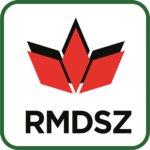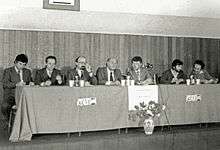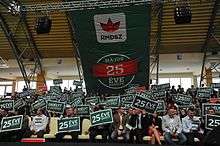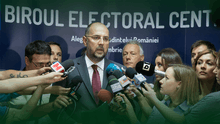Democratic Alliance of Hungarians in Romania
Democratic Alliance of Hungarians in Romania | |
|---|---|
 | |
| President | Hunor Kelemen |
| Senate leader | Tánczos Barna |
| Chamber leader | Márton Árpád |
| Founded | 25 December 1989 |
| Headquarters |
Bucharest (presidency) Cluj-Napoca (presidency and executive presidency)[1] |
| Ideology |
Hungarian minority interests Liberal conservatism[2] Pro-Europeanism |
| European affiliation | European People's Party |
| International affiliation | Centrist Democrat International |
| Colours | Green and red |
| Seats in the Senate |
8 / 165 |
| Seats in the Chamber |
17 / 412 |
| Seats in the European Parliament |
2 / 32 |
| Website | |
| www.dahr.ro | |
The Democratic Alliance of Hungarians in Romania (DAHR, Hungarian: Romániai Magyar Demokrata Szövetség, RMDSZ; Romanian: Uniunea Democrată Maghiară din România, UDMR) is the main political organisation representing the ethnic Hungarians of Romania.
Officially organised as a national minority organization (not as a party), RMDSZ nevertheless acts as one of the main parties of Romania. From 1990 the RMDSZ is a parliamentary party, it has its own representatives in the Senate and in the Chamber of Deputies. From 1996 UDMR was junior coalition partner in several Romanian Gorvernments. From 2007 the RMDSZ has members in the European Parliament.
Status
RMDSZ is not a legally registered political party, but takes part in elections under art. 4(2) of the Law 68/1992 which assimilates organizations representing national minorities to political parties from an electoral point of view. RMDSZ is an "alliance" of the ethnic Hungarian community in Romania, which incorporates several platforms of different ideologies, social, scientific, cultural or professional groups as associated organizations, youth and women organisations. RMDSZ represents the Magyar (ethnic Hungarian) community of Romania (1,237,746 citizens, according to the 2011 census). Hungarians represent 18.9% of the total population of Transylvania;[3] in Szeklerland (Harghita, Covasna and part of Mureș counties) they form the majority. The overwhelming majority (99%) of the Hungarian population of Romania lives in Transylvanian counties (Arad, Bistriţa-năsăud, Bihor, Brașov, Alba, Harghita, Hunedoara, Cluj, Covasna, Caraș-Severin, Maramureș, Mureș, Satu Mare, Sibiu, Sălaj, Timiș). In national elections, the Alliance consistently obtains around 6% of the votes, which roughly corresponds to the percentage of ethnic Hungarian voters (6,5%).
History
RMDSZ was founded on the 25th of December 1989, immediately after the fall of the Communist dictatorship in the Romanian Revolution of 1989 to represent in public the interests of the Hungarian community in Romania. Its first president was the writer Géza Domokos.
RMDSZ obtained consistent results during the 1990, 1992, 1996, 2000, 2004, 2008 and the 2012 elections, gaining representation in both houses of the Parliament, until 1996, the RMDSZ acted in opposition. From 1996 the party governed in a coalition with the Romanian Democratic Convention (Convenţia Democrată Română, CDR)—a wide centre-right alliance that won the elections that year—and obtained some positions in the government of Victor Ciorbea.
Four years later, the opposition party, the Social Democratic Party of Romania (PSD) won the 2000 elections. Although RMDSZ did not join the new government as a coalition partner, it did sign a series of annual contracts with the PSD in which the PSD pledged to implement certain legal rights for the Hungarian minority community in return for RMDSZ's support in parliament.


In the 2004 elections, the RMDSZ made an alliance to back Adrian Năstase of the Social Democratic Party, who was the favourite to win the presidential elections, but the surprise victory of Traian Băsescu rocked the Romanian political spectrum. After negotiations, the RMDSZ, together with the Romanian Humanist Party (now the Conservative Party), defected from the PSD alliance and pledged to form a coalition with the Justice and Truth Alliance. The RMDSZ obtained positions in the government. After the 2008 Romanian legislative elections RMDSZ entered in opposition. In 2009, after the adoption of a motion of no confidence against the Emil Boc’s left and right grand coalition government, the RMDSZ became part of the new Emil Boc Cabinet, and continued after Emil Boc’s resignation as junior coalition partner of the Mihai Razvan Ungureanu Cabinet together with the PDL and UNPR. In 2012 the Romanian Parliament voted a motion of no confidence against the Ungureanu Cabinet. After the formation of the USL social-liberal government led by Victor Ponta, the RMDSZ entered the opposition. After the 2012 elections the same parties continued to form a government under the leadership of Victor Ponta. In 2014 the liberal part of the party coalition left the government, while the RMDSZ, PC and UNPR joined the new government. The RMDSZ left the government in December 2014, shortly after the landslide victory of Klaus Iohannis as President of Romania. Since 2014 the RMDSZ is in opposition.
Structure
The organization's president is Hunor Kelemen, elected at a party congress in 2011. Béla Markó, a writer, had held the position from 1993. He in turn was preceded by founding president Géza Domokos, in office from 1990 to 1993.
RMDSZ is structured into 22 territorial organizations, covering all regions of Transylvania, the capital Bucharest, several counties outside Transylvania, as well as platforms representing different political ideologies (Christian Democratic, Socialist, Liberal, National Liberal). It has several associated partners and groups representing the civil society, or the social, scientific, artistic or professional domains. As decision-making bodies, the RMDSZ operates the Congress, the Council of Representatives, the Permanent Council and the Presidency The executive presidency is the executive body of the alliance. The consulting bodies of the alliance are: the Consulting Council of Regional Presidents, the Consulting Council of Platforms and the National Council of Self-governments. The bodies credited with controlling are the Regulation Control Committee, the Ethics and Disciplinary Committee. In addition, the President regularly conveys other consultative bodies such as the Economic Council and the Foreign Council.

Doctrine
As an ethnic minority organization representing the Romanian Magyars the RMDSZ, above all, concerns itself with Hungarian minority rights, including cultural and territorial autonomy.
The most important objectives of the RMDSZ are the preservation and development of the Hungarian community in Transylvania, the achievement of the different types of autonomy: cultural autonomy for the smaller and most vulnerable communities and the territorial autonomy and self-determination for those living in large majority area. The use of the mother tongue in all segments of private and public life, the education in mother tongue, the administration of all establishments in the area of minority education and culture are the most important elements of the daily struggle of the RMDSZ.
The alliance has undertaken the task of representing the interests of the Hungarian community of Romania in Romanian and European politics as well. Ever since its establishment, the formation supported the necessity of a united political life, one single voice, that expresses the goals of the Hungarian minority in Romania.This is based on the principle that,as a minority, the Transylvanian Hungarian community should politically be represented by a single, united organization that would offer a framework for varied ideologies and not by various political parties. The RMDSZ seeks to establish equal to equal relations with Romanian and European political actors expecting their support in pursuing the goals of the Hungarian community.The RMDSZ is convinced the Hungarian community in Romania is the only entity entitled to make decisions concerning the Hungarian community in Romania.
The RMDSZ focuses on cooperation and dialogue with the majority. Participating in the governing coalition is important as the alliance can greatly contribute through governmental means to the improvement of the life of the Hungarian community in Romania. The presence and role in the Romanian government of the RMDSZ protects the status and future of ethnic minorities in Romania and safeguards their evolution. The presence of the RMDSZ in the Romanian government is not limited to benefits in the field of Romanian politics: the fact bears an important message for states in the vicinity of Hungary, where ethical issues have lately appeared to be increasingly problematic. Since 1999 the RMDSZ is a member of the European People's Party (EPP), and since 1991 it is member of the Federal Union of European Nationalities – FUEN.
Various specific goals, gradually detailed during the years, include:
- Free use of mother tongue in private and public life, as well as in administration and justice.
- Development of a native-language school system, with all levels and all types of instruction.
- Full restitution of the community and Church-owned properties that were confiscated during the Communist regime.
- Autonomy and self governance for Szeklerland.
- Cultural autonomy for all national minorities in Romania (national minority law in the Romanian Parliament 2005).
- Decentralization of administration
RMDSZ leaders have claimed on several occasions that they believe local autonomy (decentralization) to be the most appropriate and efficient form of self-government. However, RMDSZ has also stated that it wishes to achieve this goal only through a dialogue and consensus with the Romanian majority, and based on proven Western European models.
RMDSZ has been criticized on several occasions for its lack of specific doctrine. The main argument for preserving the current structure is that if it split up into smaller fractions of different ideological orientations, it would be impossible for the Hungarian community to obtain more seats in the Parliament (one single seat is allocated to each minority group by default) due to the electoral threshold of 5%.
Several voices from within the RMDSZ and the Hungarian community have criticized it for being too moderate, and making too many compromises in political treaties with other Romanian parties. The Hungarian Civic Alliance, formed by Hungarians against the RMDSZ, and the Hungarian People’s Party from Transylvania formed by former members of the RMDSZ aimed to form separate, more radical, political entityies. However, during the 2004 and 2008 elections, the RMDSZ has proved to still have the support of the overwhelming majority of Hungarians. Disputes with this fraction-group led to the departure of László Tőkés (who was in support of the break-away group) from the position of honorary president. In 2009 László Tőkés joined, as frontrunner, the Hungarian Unity list for the European Parliamentary elections in Romania, but as elected Member of the European Parliament, he became an independent politician and resigned from his RMDSZ membership.
Achievements
1989-1999
- Developments in the educational system, including reclaiming for Hungarian-language education in some (though not all) schools that were transformed during the Communist regime.
 President of the RMDSZ KELEMEN Hunor as a candidate at the 2014 Romanian Presidential Elections
President of the RMDSZ KELEMEN Hunor as a candidate at the 2014 Romanian Presidential Elections - The law that allowed partial restitution of real estate confiscated during the Communist regime.
- Amendment to the administrative law, allowing for the use of Hungarian names of towns and villages as well as Romanian names (on public signs and indicators) where Hungarians live in numbers larger than 20%.
2000 – 2004
- Adoption of restitution law of community forest, community and church real estates.
- Construction of new educational establishments, conservation of important historical buildings.
- Implementation of language rights in administration and justice.
- The inauguration of the symbolic Liberty (Szabadság) statute in Arad, demolished by the communist regime.
2004 – 2008
- Establishment of the Institute for Minority Studies in Cluj.
- Establishment of new schools for professional education.
- Construction of sport establishments across Transylvania.
- The opening of the General Consulate of Hungary in Miercurea-Ciuc.
- Availability of a Hungarian language telephone directory.
2010
- Decentralization process in the education and in health services.
- The History and Geography of Romani can be learned in mother tongue.
- The Hungarian language education benefits from more funding, the establishments are administrated by the local authorities.
2011
- Important public investment were channeled into Hungarian led local communities, including sewage and water systems.
- The renewal of the 12 national road across Szeklerland.
- The RMDSZ managed to stop the intention of the political majority to create new and bigger administrative units, which would mint the diminution of Hungarian led counties.
2012 - 2013
- The establishment of a Council for Cultural Autonomy, aiming to create a network of all goods and heritage of the Hungarian community in Romania.
- The RMDSZ presented the Transylvania 2020 project about the investment opportunities and development of the EU funding based on the 2014-2020 MFF of the EU.
- The RMDSZ together with the FUEN and the SVP from South Tyrol initiated the Minority SafePack European Citizens’ Initiative.
Electoral performance
| Election | Votes | % | Chamber | Senate | Position | Government |
|---|---|---|---|---|---|---|
| 1990 | 991,601 | 7.23 | 29 / 395 |
12 / 119 |
2nd | Opposition |
| 1992 | 811,290 | 7.46 | 27 / 341 |
12 / 143 |
5th | Opposition |
| 1996 | 812,628 | 6.64 | 25 / 343 |
11 / 143 |
4th | Coalition |
| 2000 | 736,863 | 6.80 | 27 / 345 |
12 / 140 |
5th | Opposition |
| 2004 | 628,125 | 6.17 | 22 / 332 |
10 / 137 |
4th | Coalition |
| 2008 | 425,008 | 6.17 | 22 / 334 |
9 / 137 |
4th | Coalition |
| 2012 | 380,656 | 5.14 | 18 / 412 |
9 / 176 |
4th | Opposition |
Note
| Wikimedia Commons has media related to Democratic Union of Hungarians in Romania. |
- ↑ UDMR statute (Hungarian); UDMR contacts (Romanian)
- ↑ "Democratic Union of Hungarians in Romania (UDMR)". Retrieved 4 August 2016.
- ↑ (Romanian) "Comunicat de presă privind rezultatele definitive ale Recensământului Populației și Locuințelor – 2011", at the 2011 census site; accessed 10 July 2013